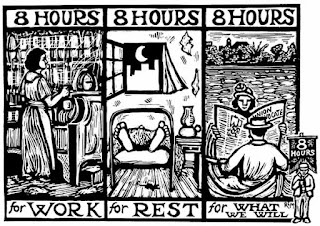When you are writing, you do not need to be as good as Poe, Shakespeare or Rowling. You need to be as good as you! @TyasMargarita
5/21/2014
5/01/2014
MAY DAY !
Internationally the First of May is known and celebrated as the workers’
holiday. In America, on the other hand, the First Monday in September is
officially set aside as Labor Day, and those who insist, in the international
spirit, on celebrating May Day are obliged to do so in defiance of the
country’s established custom for the sake of greater harmony with the prole-
tariat of the world.
May Day faces the relationship of capital and labor in the Marxian
spirit of the class struggle; Labor Day sticks to the hollow pretense of a
brotherhood between capital and labor instilled through Samuel Gompers into the
American Federation of Labor.
May Day Born in the United
States
The First International ceased to exist as an international organization
in 1872, when its headquarters were removed from London to New York, although
it was not officially disbanded till 1876. It was at the first congress of the
reconstituted International, through the initiative of the delegate of the
Socialist Labor Party of America to the International Socialist Congress held in
Paris, France, in July, 1889, that May First was set aside as a day upon which
the workers of the world, organized in their political parties and trade
unions, were to fight for the important political demand: the 8-hour day. The
Paris decision was influenced by a decision made at Chicago five years earlier
by delegates of a young American labor organization – the Federation of Organized
Trades and Labor Unions of the United States and Canada, later known under the
abbreviated name, American Federation of Labor.
The prime object of the resolution was a proclamation to the capitalist
world of the international solidarity of the working class. On this one day in
the year the workers of all countries and climes, despite differences in
customs, traditions and languages, could unite to demonstrate to the world that
as members of the same class, the ex- ploited, the world proletariat, their
interests were the same, and that like members of one family they stand united
for the overthrow of world capitalism, and the establishment of an International
Socialist Republic, a world of harmony, peace and freedom to all men.
Traditional May Day celebrations
May
Day is related to the Celtic festival of Beltane and the Germanic festival of Walpurgis Night. May Day falls half a year from November
1 – another cross-quarter day which is
also associated with various northern European paganisms and the year in the Northern Hemisphere – and
it has traditionally been an occasion for popular and often raucous
celebrations.
As
Europe became Christianized, the pagan
holidays lost their religious character and either changed into popular secular
celebrations, as with May Day, or were merged with or replaced by new Christian
holidays as with Christmas, Easter,
and All Saint's Day. In the
20th and continuing into the 21st century, many neopagans began reconstructing the old traditions and
celebrating May Day as a pagan religious festival again. Note
that the source noted does not support any of the changes claimed by the
previous statement. The only significant Christianization of May day is
essentially localized to Germany where it is one of many historic days that
were used to celebrate St. Walburga (the saint credited with bringing
Christianity to Germany).
The Future Belongs to Communism
For
the May Day, 1923, edition of the Weekly Worker, C. E. Ruthenberg wrote:
"May Day – the day which inspires fear in the hearts of the capitalists
and hope in the workers – the workers the world over – will find the Communist
movement this year stronger in the U. S. than at any time in its history....
The road is clear for greater achievements, and in the United States as
elsewhere in the world the future belongs to Communism." In a Weekly
Worker of a generation before, Eugene V. Debs wrote in a May Day edition of the
paper, published on April 27, 1907: "This is the first and only International
Labor Day. It belongs to the working class and is dedicated to the
Revolution."
The
world is nearer to Communism today. We are living in a more advanced period
now. Capitalism has swung downward and is progressively moving in that
direction. The sharpness of its own contradictions is making its ability to
carry on more difficult. The workers are growing in political consciousness and
are engaged in a counter-offensive which is gaining in scope and depth. The
oppressed colonial and semi-colonial peoples are rising and challenging the
rule of imperialism.
In
the Soviet Union the workers will review on May Day the phenomenal achievements
of the building of Socialism. In the capitalist countries May Day will be as
always a day of struggle for the immediate political demands of the working
class, with the slogans of proletarian dictatorship and a Soviet Republic kept
not far in the background.
Source :
https://www.marxists.org/subject/mayday/articles/tracht.html
http://en.wikipedia.org/wiki/May_Day
mayday_vs_ld_omj.pdf
Subscribe to:
Comments (Atom)

